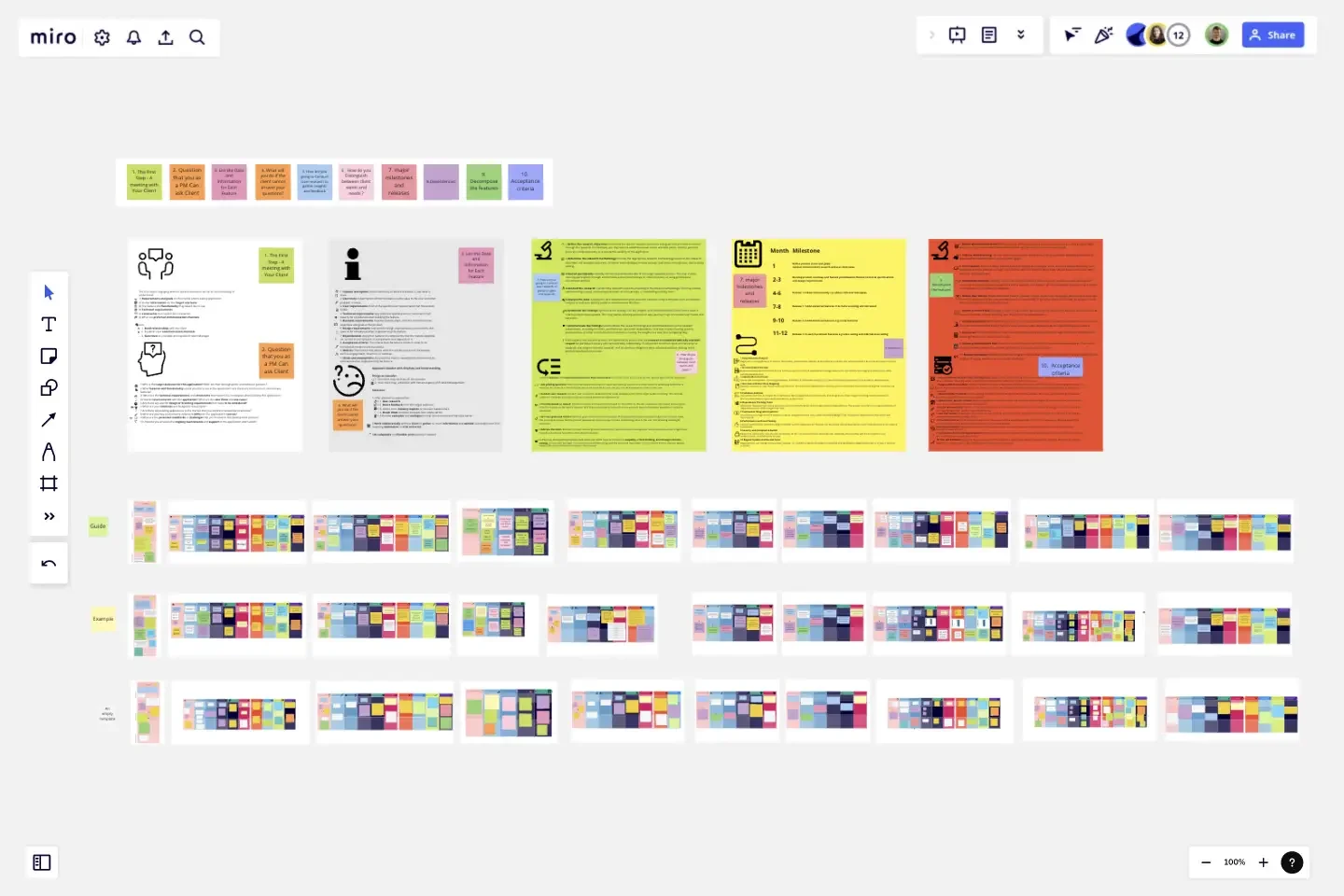Product Management - Product Flow
Streamline product development processes using Product Management - Product Flow template. Visualize stages, tasks, and dependencies for improved workflow.
Trusted by 65M+ users and leading companies
Engaging with a Client
Purpose: Outline the initial approach to client engagement.
Content: Best practices for first meetings, communication strategies, and establishing rapport.
Questions for the Client
Purpose: Identify critical questions to understand the client's vision and requirements.
Content: Open-ended questions focusing on the client's goals, target audience, expected features, budget, and timeline.
Data Collection for Each Feature
Purpose: Specify the type of data needed for understanding each feature.
Content: Data types like user demographics, market analysis, and technical requirements for the calling and messaging features.
Information Collection for Each Feature
Purpose: Elaborate on the detailed information required for each feature.
Content: API integrations, hardware compatibility, and user interface requirements.
Handling Non-responsive Clients
Purpose: Strategies for proceeding when the client is unresponsive or unclear.
Content: Using industry benchmarks alternative research methods, reaching out to stakeholders.
Conducting User Research
Purpose: Detailing the approach for gathering user insights.
Content: Methods like surveys, interviews, focus groups, user personas, and usage scenarios.
Distinguishing Client Wants vs Needs
Purpose: Framework for identifying and prioritizing client requests.
Content: Techniques to differentiate between essential features and desirable additions, balancing business goals and user needs.
High-Level Timeline
Purpose: Outlining significant milestones and releases over 12 months.
Content: Gantt chart or timeline showing phases like planning, development, testing, launch, and post-launch support.
Top 10 Features with Dependencies
Purpose: Identify key features and their dependencies or constraints.
Content: Detailed list of features with associated technical, resource, or time dependencies.
Decomposing Features
Purpose: Break down each feature into manageable components.
Content: For each feature, list sub-features, tasks, and responsible teams or individuals.
Acceptance Criteria for a User Story
Purpose: Define clear criteria for evaluating whether a user story is complete.
Content: Specific, measurable criteria for one user story, demonstrating what success looks like for that feature.
This template was created by Mark V. Smetanin.
Get started with this template right now.
User Story Map Template
Works best for:
Marketing, Desk Research, Mapping
Popularized by Jeff Patton in 2005, the user story mapping technique is an agile way to manage product backlogs. Whether you’re working alone or with a product team, you can leverage user story mapping to plan product releases. User story maps help teams stay focused on the business value and release features that customers care about. The framework helps to get a shared understanding for the cross-functional team of what needs to be done to satisfy customers' needs.
Gantt Chart Template
Works best for:
Project Management, Mapping, Roadmaps
Simplicity, clarity, and power — that’s what make Gantt charts such a popular choice for organizing and displaying a project plan. Built upon a horizontal bar that represents the project progress over time, these charts break down projects by task, allowing the whole team to see the task status, who it’s assigned to, and how long it will take to complete. Gantt charts are also easily shareable among team members and stakeholders, making them great tools for collaboration.
Stakeholder Analysis Template
Works best for:
Project Management, Strategic Planning, Project Planning
Managing stakeholders is integral to completing a project on time and meeting expectations, so here’s how to use a stakeholder analysis to help. A stakeholder analysis empowers you to meet expectations and complete projects on time by identifying individuals, groups, and organizations with a vested interest in a program or process. In a typical stakeholder analysis, you’ll prioritize stakeholders based on their influence on a project and seek to understand how best to interface with them throughout the course of the project.
Taco Tuesday Retrospective
Works best for:
Agile Methodology, Retrospectives, Meetings
The Taco Tuesday Retrospective template offers a fun and informal approach to retrospectives, perfect for fostering team camaraderie. It provides elements for reflecting on past iterations over a casual taco-themed gathering. This template enables teams to relax, share insights, and brainstorm ideas in a laid-back atmosphere. By promoting social interaction and creativity, the Taco Tuesday Retrospective empowers teams to strengthen relationships, boost morale, and drive continuous improvement effectively.
Product Ownership Evolution Model (POEM)
Works best for:
Product Management, Planning
The Product Ownership Evolution Model (POEM) template guides product teams through the evolution of product ownership roles and responsibilities. By illustrating the transition from individual ownership to shared ownership, this template fosters collaboration and accountability. With sections for defining roles, establishing workflows, and setting expectations, it facilitates smooth transitions and enhances team effectiveness. This template serves as a roadmap for optimizing product ownership practices and driving continuous improvement.
Business Plan Template
Works best for:
Strategy & Planning
The Business Plan Template not only streamlines the complex task of crafting a business plan but also enhances collaboration and creativity. Whether you're a seasoned entrepreneur or just starting, Miro's Business Plan Template offers a practical, comprehensive solution to turn your business ideas into actionable strategies.
